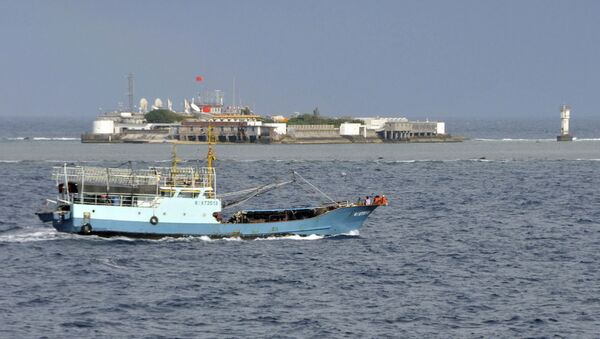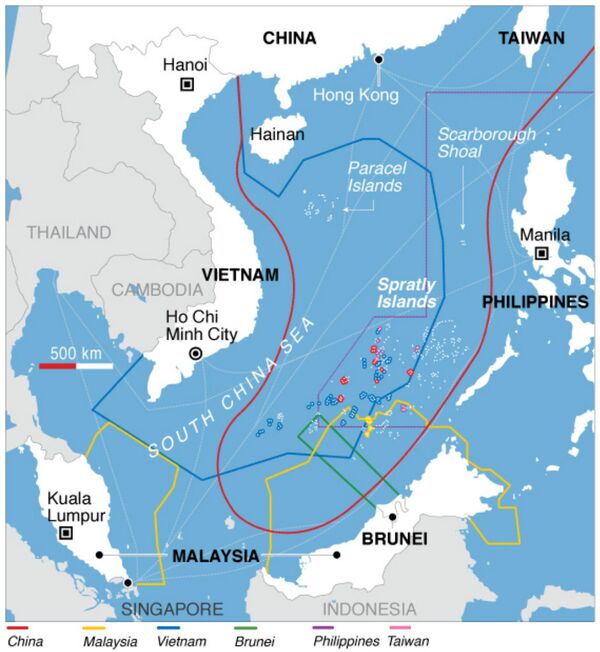The Chinese military bases constructed on artificial islands in the contested South China Sea waterway are too small, too distant from the mainland and too vulnerable to potential enemy strikes, according to a Beijing-based monthly magazine, Naval and Merchant Ships.
Published by the country’s State Shipbuilding Corporation, which builds naval vessels associated with the People's Liberation Army, the outlet is quoted by South China Morning Post as saying the sites had an undeniable role in asserting Beijing’s claim over about nine-tenths of the South China Sea.
Certain parts of the strategic hydrocarbon and fishing resources-rich body of water, which is also home to vital shipping lanes, feature in a spate of overlapping claims from countries such as Vietnam, Malaysia, Brunei, the Philippines and Taiwan, leading to disputes with Beijing.
China has been increasingly assertive over what it insists are its centuries-old claims to the contested region, turning islands and reefs in the South China Sea into military bases and airstrips to back up those claims.
While convenient for the needs of intelligence gathering and reconnaissance, the inherent weaknesses of the bases might potentially render them defenceless if they come under attack and they are of little use in a conflict, says the magazine.
“These artificial islands have unique advantages in safeguarding Chinese sovereignty and maintaining a military presence in the deep ocean, but they have natural disadvantages in self-defence,” the magazine said.
‘Vulnerable to Attack’
China transformed three disputed tidal reefs into stationary aircraft carriers in the period between 2014 and 2017. The bases are equipped with runways, hangars capable of deploying aircraft including fighter jets, have surface-to-air missiles and have temporarily hosted anti-ship cruise missiles, writes the magazine.
However, a set of natural features suggest the military sites have specific weaknesses.
Firstly, the remote and isolated bases are far from the mainland, and as such, difficult to defend and supply in the event of an attack.
The magazine cites as an example the Fiery Cross Reef, where one of the bases is situated. It would reportedly take a naval support vessel 20 hours to cover the 1,000 km (600 miles) to base from the closest resupply site on Hainan island.
"Even if the support fleet rushes at the fastest speed, it will take more than a day to reach it," the report says.
New #fire on the #water in the South #China #Sea
— Dana White (@DanaWhi19160134) February 6, 2019
China’s #construction of a #rescue #center on #contested Fiery Cross #reef is making big #political #waves in the Philippines
Link-https://t.co/UKK3LECFLT#political #wave #fault #lines #Fiery #Cross #think #tank #communications pic.twitter.com/zmcKrVAZZ2
Secondly, the bases are also vulnerable to potential enemy attack as China’s J-16 fighter jets do not possess the range to patrol the area effectively, writes the outlet. Jet fighters would be likely to expend most of their fuel in flying the long distances between bases.
Furthermore, the base’s sole runway would not allow it to support more than one aircraft at a time.
Thirdly, the island’s low-lying position and insufficient physical shelter means natural phenomena such as high tides and storms become a challenging issue, while there is also no protection against a possible missile attack.
“Island shelters lack vegetation, natural rock and soil and other coverings, and the altitude is low, while the groundwater level is high. Personnel and resources cannot be stored underground for a long time," writes the magazine.
The publication warned that nearby islands were held by rival claimants, such as the Philippines or Malaysia.
If the US were to extend support to its allies in a conflict, China’s military bases could potentially be attacked from multiple approaches, such as the Philippine island of Palawan, to the east of the Spratlys, or the Strait of Malacca to the west.
Amid the ongoing tensions in the South China Sea, in recent times the US, which challenges Beijing's claims to the contested waterway, increased its military presence, including jets and vessels, close to the borders of China. The US moves, which have also included a spate of military drills, have been perceived as threatening by Beijing.
Comprised of both Nimitz and Ronald Reagan Strike Groups, the Nimitz Carrier Strike Force celebrated #IndependenceDay with unmatched sea power while deployed to the South China Sea conducting dual carrier operations and exercises in support of a free and open Indo-Pacific. pic.twitter.com/vseDy5HLVY
— U.S. Navy (@USNavy) July 4, 2020
Despite China and ASEAN negotiating a ‘code of conduct’ for the region since 2002, progress has been negligible amid US efforts to forge bilateral alliances with regional powers and engage in ‘freedom of navigation’ missions throughout the area.



